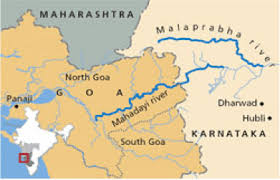Malprabha River is a major river in the southern Indian state of Karnataka. It is a tributary of the Krishna River and originates in the Western Ghats at an altitude of about 792 meters above sea level. The river flows through the districts of Belagavi, Bagalkot, and Vijayapura before merging with the Krishna River in the state of Andhra Pradesh. The river has a total length of about 360 kilometers and a catchment area of 20,362 square kilometers.

Table of Contents
Irrigation
The Malprabha River is an important source of water for irrigation and drinking purposes in the region. It is a major source of water for the Malprabha Dam, which is located near the town of Saundatti in the Belagavi district. The dam provides water for irrigation to more than 300,000 hectares of agricultural land in the region. The river is also an important source of water for the city of Belagavi and other towns and villages in the region.
Cultural Aspect of Malprabha River
The Malprabha River has a rich cultural and historical significance. The river was mentioned in ancient Hindu texts such as the Mahabharata and the Skanda Purana. The river has also been an important trading route in the region for centuries. The region around the river is home to several important historical and cultural sites such as the Saundatti Fort, the Badami Caves, and the Aihole Temple Complex.
Challenges faced by Malprabha River
Despite its cultural and historical significance, the Malprabha River faces several environmental challenges. The river is heavily polluted due to the discharge of untreated sewage and industrial effluents into the river. The pollution has caused the river to lose its natural biodiversity and has impacted the health of the people and animals that depend on the river. The pollution has also impacted the tourism industry in the region.
To address these environmental challenges, the government and various non-governmental organizations (NGOs) have taken several initiatives. The government has initiated several projects to treat sewage and industrial effluents before discharging them into the river. The government has also implemented strict regulations to control the discharge of pollutants into the river. Several NGOs are also working towards creating awareness about the importance of the river and its conservation.
Apart from environmental challenges, the Malprabha River also faces several social and economic challenges. The region around the river is predominantly agricultural, and the livelihoods of the people in the region are heavily dependent on the river. The river is also an important source of fish and other aquatic resources. However, due to overfishing and other factors, the fish population in the river has declined in recent years. This has impacted the livelihoods of the people who depend on fishing.
Solution
To address these social and economic challenges, the government and NGOs have taken several initiatives. The government has initiated several programs to promote sustainable agriculture practices and to diversify the livelihoods of the people in the region. NGOs are also working towards creating awareness about sustainable fishing practices and promoting the conservation of aquatic resources.
In conclusion, the Malprabha River is an important river in the southern Indian state of Karnataka. The river has a rich cultural and historical significance and is an important source of water for irrigation and drinking purposes in the region. However, the river faces several environmental, social, and economic challenges that need to be addressed to ensure the sustainable development of the region. The government and NGOs are taking several initiatives to address these challenges, and it is important to create awareness about the importance of the river and its conservation among the people in the region.
Important Links